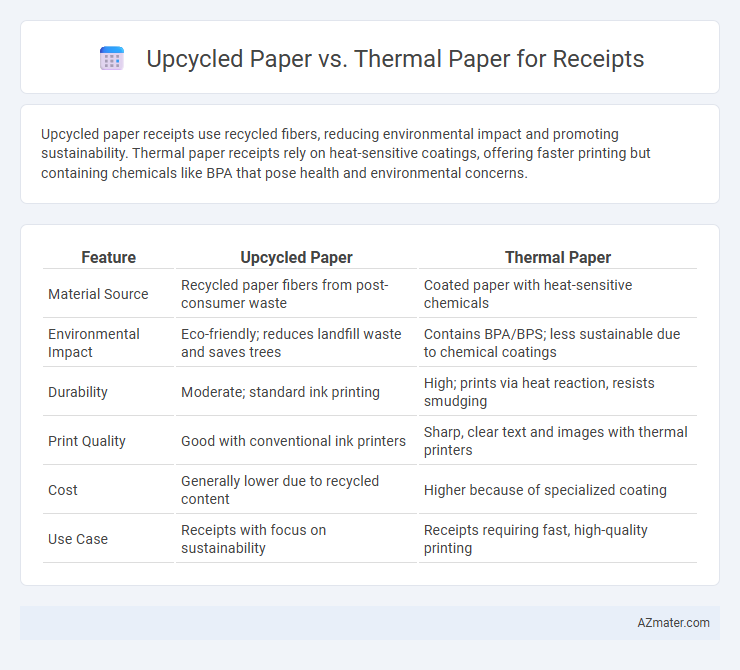Upcycled paper receipts use recycled fibers, reducing environmental impact and promoting sustainability. Thermal paper receipts rely on heat-sensitive coatings, offering faster printing but containing chemicals like BPA that pose health and environmental concerns.
Table of Comparison
| Feature | Upcycled Paper | Thermal Paper |
|---|---|---|
| Material Source | Recycled paper fibers from post-consumer waste | Coated paper with heat-sensitive chemicals |
| Environmental Impact | Eco-friendly; reduces landfill waste and saves trees | Contains BPA/BPS; less sustainable due to chemical coatings |
| Durability | Moderate; standard ink printing | High; prints via heat reaction, resists smudging |
| Print Quality | Good with conventional ink printers | Sharp, clear text and images with thermal printers |
| Cost | Generally lower due to recycled content | Higher because of specialized coating |
| Use Case | Receipts with focus on sustainability | Receipts requiring fast, high-quality printing |
Introduction to Receipt Paper Types
Receipt paper types primarily include upcycled paper and thermal paper, each serving distinct environmental and functional roles. Upcycled paper is made from recycled materials, reducing waste and promoting sustainability, while thermal paper uses heat-sensitive coatings to produce images without ink, offering fast and clear printing. Understanding these types helps businesses choose the best option based on ecological impact, print quality, and cost-efficiency.
What is Upcycled Paper?
Upcycled paper for receipts is created by transforming pre-used paper materials into new paper products, reducing waste and conserving natural resources. Unlike thermal paper, which relies on heat-sensitive chemicals for printing, upcycled paper supports eco-friendly business practices by minimizing environmental impact and promoting recycling. This sustainable alternative is ideal for companies prioritizing green initiatives without compromising receipt quality.
What is Thermal Paper?
Thermal paper is a specially coated paper that changes color when exposed to heat, making it ideal for use in thermal printers found in receipt printing. It does not require ink, toner, or ribbons, which reduces printing costs and maintenance. However, thermal paper often contains chemicals like BPA or BPS, raising environmental and health concerns compared to eco-friendly alternatives like upcycled paper.
Environmental Impact: Upcycled vs Thermal
Upcycled paper receipts significantly reduce environmental impact by reusing existing paper fibers, lowering deforestation and energy consumption during production. Thermal paper, often coated with bisphenol A (BPA) or bisphenol S (BPS), poses ecological concerns due to chemical runoff and challenges in recycling processes. Choosing upcycled paper supports sustainable waste management and decreases harmful chemical exposure compared to thermal paper receipts.
Cost Efficiency Comparison
Upcycled paper receipts typically offer lower production costs due to the reuse of fiber materials, reducing raw material expenses compared to thermal paper. Thermal paper requires a heat-sensitive coating that increases manufacturing costs, which can lead to higher prices per roll for businesses. Over time, upcycled paper can improve cost efficiency by minimizing supply expenses and supporting sustainable procurement strategies.
Durability and Print Quality
Upcycled paper receipts offer moderate print quality with a slightly grainy texture but generally provide good durability for short-term use, making them eco-friendly alternatives. Thermal paper receipts deliver sharper, high-contrast print quality with smooth surfaces, ensuring excellent legibility and resistance to smudging or fading in the short term. However, thermal paper is more sensitive to heat and light exposure, which can undermine long-term durability compared to upcycled paper.
Health and Safety Concerns
Upcycled paper receipts often contain fewer harmful chemicals compared to thermal paper, which frequently uses BPA or BPS as color developers linked to potential hormonal disruptions. Thermal paper's chemical coatings can transfer to skin, posing risks especially with frequent handling, while upcycled paper typically offers a safer alternative with reduced toxicity. Choosing upcycled paper for receipts supports better health and safety by minimizing exposure to endocrine-disrupting substances found in traditional thermal paper products.
Recycling and Disposal Processes
Upcycled paper receipts offer significant environmental benefits through enhanced recyclability, as they contain fewer chemical additives and inks, making them easier to process in conventional paper recycling streams. Thermal paper, often coated with BPA or BPS chemicals, poses challenges for recycling facilities and typically requires specialized disposal methods to prevent contamination. Proper disposal of thermal paper involves segregating it from recyclable paper waste and directing it to designated landfill or incineration sites to minimize environmental harm.
Industry Adoption and Trends
Upcycled paper receipts are gaining traction in retail and hospitality sectors due to their lower environmental impact and alignment with sustainable business practices. Thermal paper remains widely used for fast, high-volume printing but faces scrutiny over chemical coatings like BPA, prompting some industries to explore biodegradable or recycled alternatives. Recent trends show a shift towards eco-friendly receipt options driven by regulatory pressure and consumer demand for greener solutions.
Which Receipt Paper is Better for Your Business?
Upcycled paper receipts offer an eco-friendly alternative with lower environmental impact due to recycled content, making them ideal for businesses prioritizing sustainability. Thermal paper provides crisp, fast printing and is widely compatible with most receipt printers, ensuring efficiency and clarity in transaction records. Choosing between upcycled and thermal paper depends on your business's priorities: environmental responsibility favors upcycled paper, while speed and print quality lean toward thermal paper.

Infographic: Upcycled paper vs Thermal paper for Receipt
 azmater.com
azmater.com